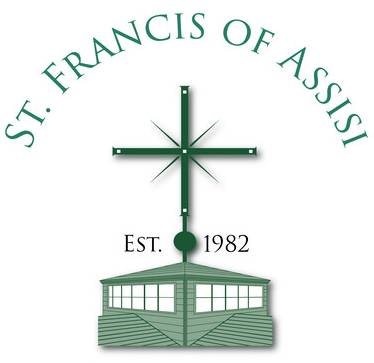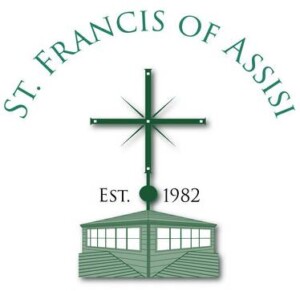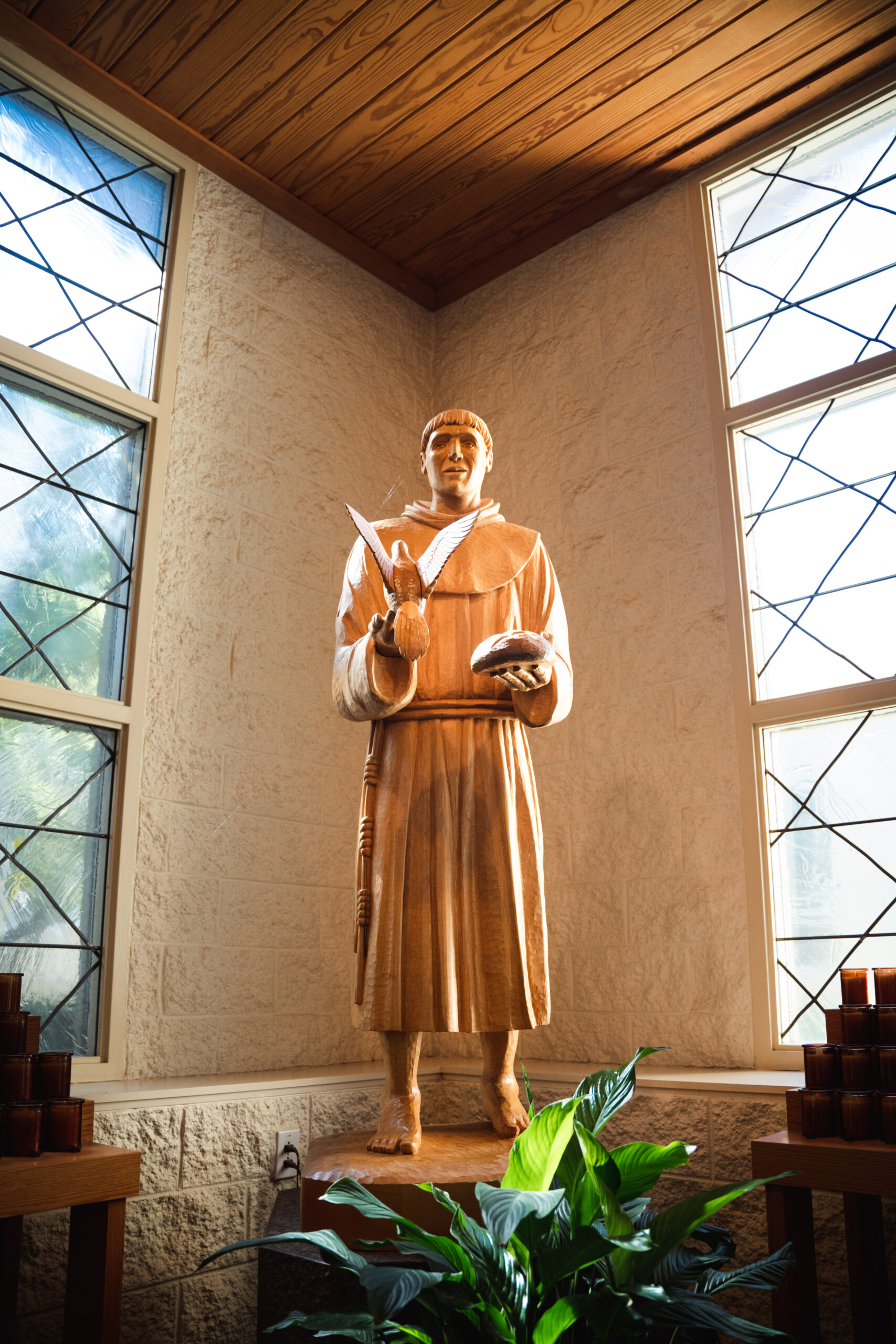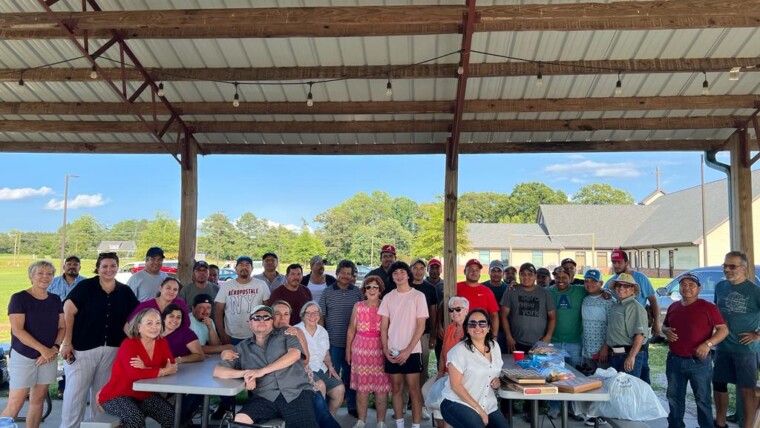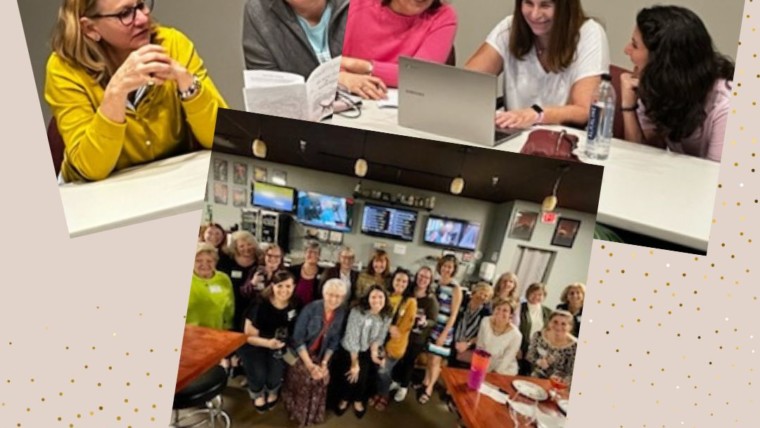St. Francis of Assisi’s founding was parishioner-driven, and even though our first pastor was a Jesuit, St. Francis and the Franciscan Mission have been the moving forces in our parish since its inception. Even the naming of the parish seemed to be a divine event. As reported by founding members of the parish the day of the dedication of the land for the future parish was bright and sunny, which led to the decision to choose St. Francis over the alternate St. Ignatius. This weather-driven choice by Pastor James English, the Jesuit founder, who deferred to his Franciscan friend Father Bob Hudak due to the fair weather, became a self-fulfilling prophecy. The Franciscan Friars took over the parish in July of 1987 and remained here for 33 years until the summer of 2020.
Our patron saint and the presence of the friars here at St. Francis established and then solidified the focus on a Franciscan mission imagined from the beginning. That mission remains mainly due to the founding tradition and dedication of the parishioners at St. Francis to that mission, but also because Father Jim Sabak remains a ‘presence’ at St. Francis, especially at The Franciscan School and St. Francis Preschool. Everybody knows Father Jim, the resident friar! Father Jim offered his insights on the process of unification of the different Franciscan provinces, potential changes to the general mission of the new Franciscan friar province, and the continuation of the Franciscan mission here at St. Francis.
Speaking of the unification process, Father Jim stressed a few points about the mission. “The unification of the provinces is going forward. However, it is not clear, in some respects, what the new organization will be focused upon or will make central to its mission and vision. While both something ‘good’ and a challenge because it opens us to reimagine the Franciscan presence in the United States, it also leaves our current ministry sites and practices in a bit of a limbo.” He recently attended the Holy Name Province’s (HNP) final chapter meeting in Albany, NY. “It was both an emotional and affirming meeting for us,” said Jim, “and it helped us to see that, whatever happens in the future, our identity and perspective as friars of HNP will be what helps the new province to succeed.” The next meeting will be the ‘Chapter of Union’ of the new province in Kansas City in October. This meeting is not an ‘open chapter’ of all friars, as was done since the 1990s in HNP, but of ‘chosen delegates’ to the chapter meeting.
Father Jim says the crucial issue of this meeting is “Determining the best friars for leadership.” He highlights, “The biggest thing to deal with immediately is the realization that both culture and history contributed to shaping the direction and mission of each of the six provinces that will join together in October.” Father Jim points out that the “Leadership for the new province is appointed and not elected as is the process for an established province. So, Rome appoints the new province of Our Lady of Guadalupe leadership.” He continues, “While the leaders won’t come from Rome, they may come from another English-speaking community worldwide.” They won’t know until August who will be in leadership roles in the province. This leadership will navigate the transition and transformation of the US provinces into one province, and in 2026 the friars will elect a leadership team from their community. Jim emphasizes, “Part of navigating into a new province will be evaluating where we are as friars and examining decisions made by the former six provinces before unification as to their effectiveness and merit. This ‘re-evaluation’ means that decisions made regarding ministries and placements will undergo assessment, especially concerning the vision and direction of the new province.”
Thinking more locally, Jim shared his thoughts on the Franciscan mission here at St. Francis, where the ‘rubber hits the road.’ “Whether or not it was intentional,” he underscores, “the Franciscans of Holy Name Province came and created a large footprint here at St Francis that other religious communities often do not attain.” How did this happen? “Leadership,” says Father Jim. “The friars came to the parish early in its existence and were given the ability to be creative in shaping it by Bishop Gossmann, Bishop Burbidge, and Bishop Zarama; the Franciscans built something unique and distinct from other parishes in the diocese, but it was never the intent of the friars to form a community independent of the diocese of Raleigh. Some still rejected what St Francis of Assisi Parish was emphasizing in parish life and ministry.” As pastor of Saint Francis, Msgr Clay has recognized and affirmed the Franciscan tradition that formed the parish, acknowledging its importance to the parish. Father Jim still worries that “a great fault of the departure of the Franciscans from Saint Francis was in the explanation provincial leadership gave for the friars’ departure, that ” the parish has learned enough to continue building upon the Franciscan tradition.” While this may be the reality for the parish, the province did not spend enough time to educate and invite the diocese into this parochial perspective.” Many parishioners have expressed concern as to “how much does the previously established Franciscan tradition at the parish matter to the diocese?” It is an excellent question to ask of any diocese because it has its character and traditions. Including a religious community among its ranks always brings a perspective to work undertaken within it and its impact on the people served by that religious tradition.
To continue the mission of the Franciscans here, Friar Jim offers some advice, “The parish needs to continue to revisit its Franciscan foundation. It might need to work more deliberately at affirming and encouraging the parish members to see themselves as Franciscan missionaries formed in this tradition and perspective for understanding church and what it means to believe in the modern world.” He believes we need to affirm laity and clergy as ‘partners in ministry,’ which was an HNP direction for all its ministries. A particular focus for Jim is the work of the LGBT and the Peace and Justice communities. “These ministries were singular in so many ways, as was its approach and response to the social and political issues facing our communities and our nation.”
He also emphasizes the formation and education opportunities here at St. Francis. “The Franciscan School (TFS) and St. Francis Preschool were established as formative places in the Franciscan tradition that built St. Francis. We must affirm this, be creative about instruction, and integrate our Franciscan identity into teaching and the curriculum.” He also points out a truism in the name of TFS. “It is important to remember that it is the ‘Franciscan school,’ not the St. Francis School, for a reason, because it was to build an identity, teach a way of life, and strengthen a world perspective in its students to meet and engage the world and our culture with the insights and values professed by Saints Francis and Clare.” Jim solidly believes this is a wise and prudent direction to maintain and grow.
Looking ahead, he is interested in seeing the parish “build, perhaps, into preaching and into the life of the parish a greater connection to its Franciscan roots.” He says. “Both the parish and diocese need to understand the history that shaped and nurtured the growth of Saint Francis. Were the Franciscans just “care-takers” of a diocesan parish, or was the presence of Franciscans in the Diocese of Raleigh seen as a benefit for the diocese in its mission to foster a life of faith that has relevance and meaning for the faithful of the diocese?” Again, in a parish of such strong ‘lay leadership,’ a way forward could be by establishing a program to educate new parishioners and priests in the tradition and the ‘why and how’ of the parish formation. “Most parishioners may not know why our buildings were named as they were, and knowing this could be a first step.” “The big thing,” Jim states, “is that the parishioners are the only part left of the Franciscan ministry and presence. While it is a bittersweet blessing, it contains power, and for our faith, power comes from remembering. To forget is to let something die; if we truly believed that the Franciscan tradition shaped and formed the parish in the best way, we must remember. The parishioners are now the only conduit and source of this memory. They must engage, speak, and envision ways to continue bringing it to life.”
Author: Mike Watson
